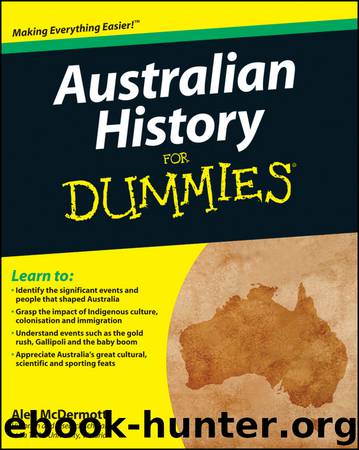Australian History for Dummies by Alex McDermott

Author:Alex McDermott [McDermott, Alex]
Language: eng
Format: epub
ISBN: 9780730376439
Publisher: For Dummies
Published: 0101-01-01T00:00:00+00:00
New Nation? Maybe. Maybe Not.
Colonial Australians in the 1880s enjoyed the highest standard of living in the world, as well as some of the most democratic governments. Colonies were self-governing, meaning Britain didn’t interfere in internal matters (although Britain still set foreign policy for the colonies). A little over ten years later the prosperity was gone, and the self-governing colonies had decided to form together into a new political entity: A federated nation.
Why Federation happened
Through the 1870s and 1880s, colonies operated like competing city-states, each with a central dominant capital as the main port and each tapping their respective vast interiors with separate railway systems. Each was self-governing, had established customs houses on their various borders, and trained their own defence forces such as local navies.
The main areas that could have created problems were internal trade and centralised defence. But these could have been solved without a federal form of government. One big problem with internal trade was that, when the states had developed their various rail networks, they’d used different rail gauges (or widths for the tracks), so the lines didn’t link up between the states. If you wanted to travel, or ship goods, by train between NSW and Victoria, for instance, you had to change trains at the border. But a centralised body could have been set up to determine a standard gauge and organise the laying of new tracks. If the push for internal free trade was strong enough, all that was needed was a customs union. If defence forces needed to be centrally coordinated (as visiting English experts advised in 1884) then, once again, a special body could be set up to do so, without going to all the extra bother of creating an entire extra layer of government and a new nation.
However, in the 1890s, colonial economies crashed and burned and the pitch ‘One Continent, One People’ became increasingly persuasive in the aftermath of strikes and chronic social disturbances.
The collapse of the old dream
The decades before 1890 had been sustained by a belief that the colonial way of life ‘had it right’. Progress and prosperity would continue to increase inevitably. While this was happening, the rule of ‘if it ain’t broke don’t fix it’ applied.
Even The Times of London agreed with this approach, arguing in 1888, ‘The prosperity and sense of security experienced by the colonies have tended to repress the desire for federation . . . [the colonies] will doubtless continue to make the same wonderful progress that [they have] done up to the present’.
At the start of the 1890s, the prosperity and sense of security came crashing to an almighty halt, and the terrible vision of intense class hatred appeared.
During the crash of the 1890s, Alfred Deakin lamented that ‘selfishness and shams, cant and materialism rule us, up and down and through and through’. Evidently a new dream was needed, something that would convert divided people into a single national community, turn ‘jarring atoms’ of divided colonial societies into ‘a united organism’.
Significantly, it
Download
This site does not store any files on its server. We only index and link to content provided by other sites. Please contact the content providers to delete copyright contents if any and email us, we'll remove relevant links or contents immediately.
| Africa | Americas |
| Arctic & Antarctica | Asia |
| Australia & Oceania | Europe |
| Middle East | Russia |
| United States | World |
| Ancient Civilizations | Military |
| Historical Study & Educational Resources |
The Songlines by Bruce Chatwin(2112)
The Fatal Shore by Robert Hughes(994)
Origins to Eureka by Thomas Keneally(713)
11 The Bear And The Dragon by Tom Clancy(611)
A Commonwealth of Thieves: The Improbable Birth of Australia by Thomas Keneally(596)
Eureka to the Diggers by Thomas Keneally(580)
Australia 1901 - 2001 by Andrew Tink(574)
A Commonwealth of Thieves by Thomas Keneally(559)
Shoot Straight, You Bastards! by Nick Bleszynski(534)
Dark Emu by Bruce Pascoe(529)
The Penguin History of New Zealand by Michael King(499)
Carnivorous Nights: On the Trail of the Tasmanian Tiger by Margaret Mittelbach; Michael Crewdson; Alexis Rockman(493)
James Cook by Peter Fitzsimons(487)
The Book Of Ian Watson by Ian Watson(481)
Venom by Brendan James Murray(481)
The Tall Man by Chloe Hooper(424)
Murder on Easey Street by Helen Thomas(395)
The Golden Country by Tim Watts(392)
Australian History for Dummies by Alex McDermott(365)
